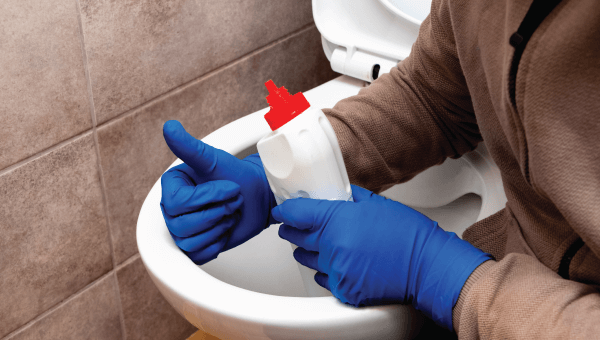
Does closing the toilet lid when flushing reduce the spread of germs?
A comprehensive study has shed light on the transmission dynamics of viruses in restroom environments, focusing on the impact of toilet lid closure during flushing and the effectiveness of toilet cleaning protocols. This research, conducted by a team of environmental scientists, reveals critical insights into how viral particles can spread within bathroom spaces, posing a risk to residents and staff alike.
For years, closing the toilet lid before flushing has been recommended as a measure to reduce the spread of aerosolised particles. Surprisingly, the study reveals that this practice may not significantly reduce the contamination of restroom surfaces with viral particles. Testing with bacteriophage MS2 as a surrogate for enteric viruses showed that the position of the toilet lid (up or down) did not notably impact the level of surface contamination in bathrooms. More importantly, the research highlights the effectiveness of cleaning practices. When toilets were cleaned with a disinfectant, a significant reduction in viral contamination was observed, not just in the toilet bowl water but also on the toilet brush used for cleaning. This points to the necessity of using appropriate cleaning agents and protocols to mitigate the risk of virus transmission through bathroom surfaces.

For care homes, these findings emphasise the need for stringent cleaning protocols that go beyond mere surface cleaning. Regular and thorough disinfection of all bathroom surfaces, including toilet bowls, seats, handles, and even cleaning tools, is crucial. The use of effective disinfectants can significantly lower the risk of viral spread within washrooms.
Enhanced Washroom Cleaning Practices
- Regular Disinfection: Ensure that all washroom surfaces are regularly disinfected with hospital-grade cleaning agents, paying special attention to high-touch areas.
- Educate Staff and Residents: Provide training on proper hygiene practices and the importance of frequent handwashing, especially after using the restroom.
- Reevaluate Cleaning Tools: Use disposable cleaning materials where possible or ensure that reusable items are disinfected after each use.
- Ventilation: Maintain good ventilation in restrooms to reduce the concentration of aerosolised particles.
By incorporating the insights from recent research into your hygiene protocols, you can significantly reduce the risk of viral transmission in your washrooms. Embracing rigorous cleaning practices and educating staff on the importance of hygiene are steps forward in protecting our most vulnerable populations in care homes.
Where To Buy Disinfectants
For those looking to enhance their care home's washroom cleanliness with effective and reliable disinfectants, Gompels offers a solution that aligns perfectly with the latest research and hygiene standards. The Soclean Antibacterial Washroom Cleaner, available in a convenient 5-litre pack of two, is designed specifically for the high demands of care homes. Its powerful antibacterial formula ensures thorough cleaning, targeting the germs and bacteria that pose health risks in communal washrooms. Compliant with key standards such as BS EN1276, EN13704, and EN14476, this cleaner ensures a high level of sanitation for bathroom floors, baths, showers, and tiles. It can be used neat or diluted, providing flexibility and efficiency in your cleaning regime.

Colour Coded Cleaning
Utilising colour-coded cleaning equipment, such as red mops and buckets available from Gompels, can significantly reduce the risk of cross-contamination between different areas of a facility. Red cleaning equipment is traditionally used for high-risk areas such as bathrooms, ensuring that these items are not mistakenly used in lower-risk areas. By adopting a colour-coded system, care homes can streamline their cleaning processes, ensuring a safer environment for both residents and staff.
Others also viewed
Hands-On Activity Ideas for Prehistoric Play and Learning
Here’s how you can use Yellow Door’s dinosaur-themed resources to create exciting learning opportunities in your setting.
How Trikes, Bikes, and Scooters Boost Early Years Development
Discover how trikes, bikes, and scooters can enhance early years development. Learn about the physical, cognitive, and social benefits these activities bring to your nursery setting.
8 Actionable Steps to Achieve an 'Outstanding' Nursery Rating
Discover actionable strategies from 2024's top-rated nurseries to help you achieve an 'Outstanding' Ofsted rating. Learn how to enhance staff interactions, curriculum, and more.
Understanding EN71 Testing And Craft Safety For Children Under 3
Discover how nurseries can safely incorporate Arts & Crafts for children under 3 with new childcare funding. Understand EN71 safety standards, why age warnings exist, and get practical tips for supervised craft activities.
Can Sun Cream Cause Prickly Heat Rash?
Learn how to prevent heat rash in children during hot weather, especially when using sun cream. This guide covers causes, symptoms, and practical tips for choosing the right sun cream and application techniques to keep...
Red Sea Attacks: Shipping Updates
Red Sea Shipping Updates and what it means for our customers.
Why Log Reduction Matters For Surface Disinfection
The numbers associated with log reduction, such as 99.9% or 99.999%, might seem trivial, but they hold profound implications for the effectiveness of a disinfectant.
Understanding COSHH in Care Homes
In the dynamic environment of a care home, the safety and well-being of both residents and staff are paramount. One crucial aspect of ensuring a secure and healthy workplace is understanding and implementing COSHH
A Pioneering Approach to Reducing UTIs in Care Homes
In 2012/2013, urinary tract infections (UTIs) topped the charts for emergency hospital admissions. The culprit? Dehydration.
Direct Gloving vs Hand Hygiene Before Donning Gloves Study
The demands on healthcare personnel, such as time constraints, high workload, and understaffing, are major barriers to strict adherence to hand hygiene. The use of gloves, while common and increasing, poses another hurdle to infection control.










